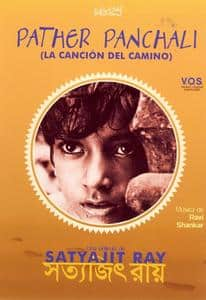

In order to raise funds during the production period, Ray kept working as a graphic designer, pawned his life insurance policy and sold his collection of LP records. Ray had to borrow money in order to shoot enough footage so as to persuade prospective producers to finance the whole film.
#PATHER PANCHALI MOVIE SUMMARY PROFESSIONAL#
Art director Bansi Chandragupta had some professional experience.įrom the outset, funding was a problem as no producer was willing to produce the film. Ray had never directed anything and cinematographer SubrataMitra had never operated a movie camera. The technical team of the film consisted of several first-timers. Boral, a village near Calcutta, was selected as the location for shooting. Satyajit Ray started the shooting of the film October 27, 1952. The role of Indir Thakrun was given to Chunibala Devi, a retired stage actress living in a brothel. For the role of Apu, Subir Banerjee was selected. The role of Sarbojaya, wife of Harihar, was played by Karuna Banerjee Uma Dasgupta played the role of Durga. Kanu Banerjee, an established Bengali film actor, portrayed the role of Harihar Ray, father of Apu and Durga. Finally, the ending of the film – the departure of the family from the village – is not the end of the novel. The scene of Apu and Durga running to catch a glimpse of the train is not there in the novel, neither child manages to see the train there, although they made an attempt. Some notable shifts from the novel in the script include the death scene of Indir Thakrun, which occurs quite early in the novel in a village shrine at the presence of some adult members of the family in the film she dies in the open in the presence of Apu and Durga. Ray himself commented that, ―The script had to retain some of the rambling quality of the novel because that in itself contained a clue to the feel of authenticity: life in a poor Bengali village does ramble.‖ Ray tried to extract and build a simple theme out of the apparently random sequences of significant as well as trivial episodes of the novel, while preserving the loitering quality of it. The film never had a complete script it was made from Ray’s drawings and notes. Besides the foreign influences, Ray is also indebted to Bengali literature and the native Indian theatrical tradition, particularly the rasa theory of classical Sanskrit drama.

The success of Bimal Roy‘s film Do Bigha Jamin inspired Satyajit Ray to hope that Pather Panchali also might find an international audience. His stay in London and watching the films there reconfirmed his conviction that it was possible to make realistic cinema with an amateur cast and shooting at actual locations. Realizing the greatness of the story, Jean encouraged Satyajit. During his visit with the French director Jean Renoir, Satyajit Ray told him his desire to make a film based on this novel. The title of the film in English is Song of the Little Road. Ray chose the novel because of certain qualities that, according to him, “made it a great book: its humanism, its lyricism, and its ring of truth.”

Satyajit Ray read the novel in 1943, when he was doing the illustrations for a new edition of it, and contemplated the possibility of making a film based on it in 1947–48. The later part of the novel, where Apu and his parents leave the village and settle in Banaras, formed the basis of Aparajito (The Unvanquished, 1956), the second film of the Apu trilogy.

The novel depicts a poor family’s struggle to survive in their ancestral rural home and the growing up of Apu, the male child in the family. The plot was based on the author’s own early life.
#PATHER PANCHALI MOVIE SUMMARY SERIAL#
It first appeared as a serial in a periodical in 1928 and was published as a book in 1929. The novel Pather Panchali by Bibhutibhushan Bandopadhyay is a classic bildungsroman in Bengali literature.


 0 kommentar(er)
0 kommentar(er)
